My First Marathon, Or: A Supposedly Fun Thing I Won't Do Again Until I've Had Time to Forget How Gruelling it Was
The marathon occupies a sweet spot in human achievement: it is a difficult physical and mental feat that requires months of training, but is accessible to almost anyone who decides they really want it.
By Ryan McGreal.
3620 words. Approximately a 12 to 24 minute read.
Posted November 07, 2016 in Blog.
(Last Updated November 25, 2016)
Contents
1 Getting Ready ↑
I started running almost three and a half years ago, in the summer of 2013, and have incorporated it into my life as a regular activity. As I have gradually gotten into better shape and become a more decent runner, it has increasingly occurred to me that sooner or later, I would have to try my hand at a marathon.
Earlier this year I ran the 30 km Around the Bay Road Race and the 25 km Sulphur Springs Trail Race, so a marathon felt like the next step. An obvious place to start is the Road2Hope Hamilton Marathon, held each year in early November.
I started training for it around four months ago. I began extending my weekend long run from around 21-22 km up to 32 km, and did three 10 km runs during the week. My weekly distance was ranging from 60-65 km, split over four runs.
I also tried to focus on improving my core strength with daily planks and pushups, and rounded things out with cross-training on a bike a couple of times a week.
There were a few hiccups, of course. At one point I found myself falling into an overtraining rut where I was feeling fatigued all the time, was craving junky carbs and could feel incipient pain in my right knee. I backed off for a couple of weeks to get ahead of the fatigue and then carefully ramped back up.
I also lost a week of training when I wrenched my lower back in the most middle-aged way possible: painting my son's bedroom.
But inevitably, the weeks rolled down and I found myself into the final three-week taper. Weeks turned into days, days turned into hours, and I was going to bed on Saturday night filled with trepidation.
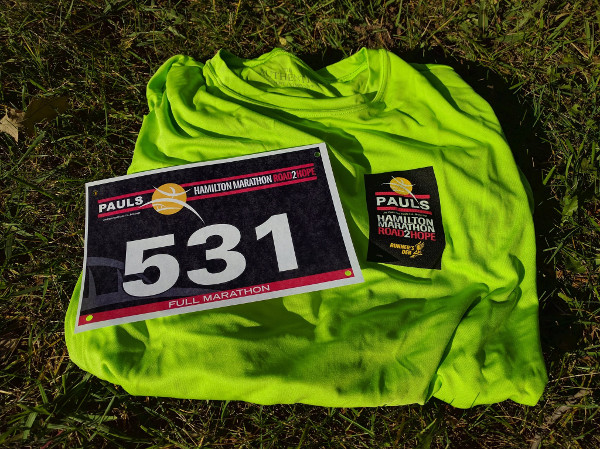
My Road2Hope shirt and bib, which I picked up on Saturday
2 Race Day ↑
I woke up at 4:30 AM on Sunday, thankful for an extra hour of sleep due to the end of daylight savings time. I drank a glass of water and had whole-grain toast with peanut butter for breakfast.
I also brewed a pot of coffee and filled a thermos to take. I don't normally drink coffee in the morning, and I have found it is a significant performance-enhancing legal drug when I do drink it. (I also took a prophylactic anti-inflammatory pill.)
I consulted my race-day checklist, which I had posted on the chalkboard in our kitchen.
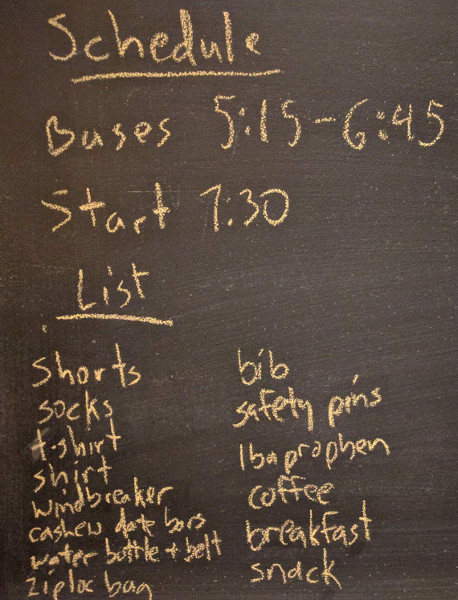
Marathon race day checklist
I agonized over what to wear to accommodate the temperature spread: from 4C on arriving to 6C at starting time to 12C by the time I reached the finish line. I ended up putting on shorts, a running t-shirt and a running long-sleeved shirt with a windbreaker over top.
I pared my other possessions down to the bare minimum: my phone (mainly for tracking the run), a small plastic bag with a couple of cashew-date bars, and another bag with my car key and my health card (you know, just in case).
I hydrated extensively the day before and early that morning, but decided in the end not to bring my own water bottle. Instead, I would stop and take a drink at each water station, approximately every three kilometres.
I left home around 5:30 AM and headed to Confederation Park, drinking as much coffee as I could before having to leave the thermos behind in my car. A line of shuttle buses was waiting to take runners up to Dofasco Park, where the marathon and half-marathon were to begin.
It was on the shuttle that I learned the organizers were offering a bag check - an amazingly convenient service that definitely would have changed how I organized my morning had I known about it. Oh, well - I'll know for next time.
I kvetched over what to do about my windbreaker, because it was kind of too cold not to wear it at the start, but it would quickly become too warm and I didn't want to have to tie it around my waist, where the zipper would repeatedly bang against my leg.
It got warmer out as the sun rose and the starting time approached, and I decided I'd rather be a bit cold than have to lug a flappy jacket for 42 km. I checked it in, a totally quick and painless activity - the event was extremely well-organized.
I met some friends who were also doing the marathon and we chatted while waiting until it was time to head out to the starting line.
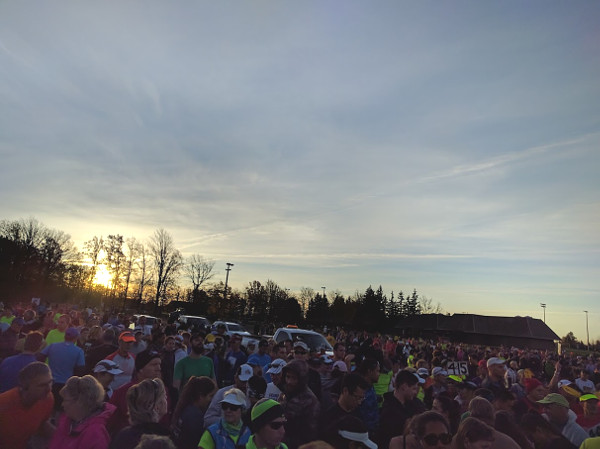
Looking back over the starting line
3 The Race Begins ↑
At 7:30 AM, the race began and I streamed out onto the road with the other marathoners - 900 people were signed up. (The half-marathoners would start 15 minutes later.)
The race proceeded north on First Road East to Ridge Road, which runs along the top of the Escarpment, and turned east. At Third Road we turned right and headed south to Green Mountain Road, where we turned left (east) and then left again (north) onto Tapleytown Road.
That took us back to Ridge Road for another eastbound turn to Fifth Road East, where we headed south to Highland Road. From there we went 7-8 km west to connect with the top of the Red Hill Valley Parkway at around the halfway point of the trip.
Early on, maybe 20 minutes or so into the race, I found the four-hour Pace Bunny, an experienced runner who maintained a steady pace that was timed to complete the race in four hours. He regularly checked his watch to modulate his pace: he had an 11:30 appointment with the finish line and didn't want to be late.
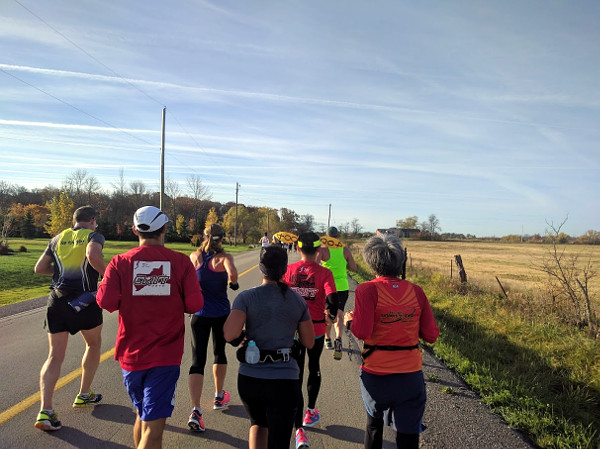
4:00 Pace Bunny (with orange bunny ears) surrounded by his flock
The Pace Bunny was fantastic, making sure to keep everyone together and even doubling back to help people who were falling behind. He was more of a shepherd than a bunny, and he took very good care of his flock. I was happy to fall in behind him, because it meant I maintained a steady and (hopefully) sustainable pace.
4 Heading Down the Escarpment ↑
The section going down the northbound lanes of the Red Hill Valley Parkway (RHVP) was a great experience. The sky was bright blue, the fall colours were vibrant and it's always fun to do something that feels subversive, like running on a highway.
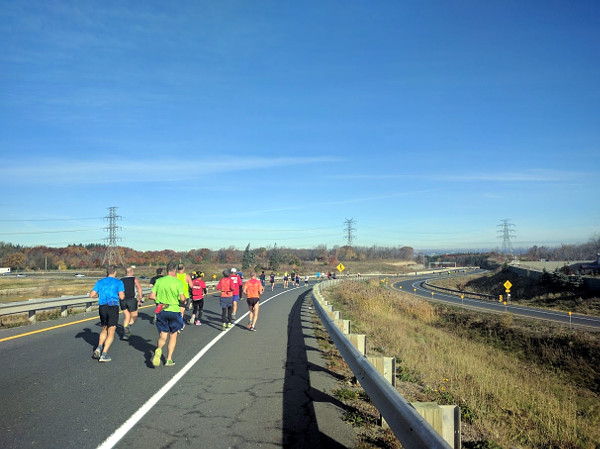
Red Hill Valley Parkway
The RHVP section is six km at a significant downgrade, and that kind of downhill running is challenging on your legs. Running downhill puts an eccentric load on your leg muscles, meaning they have to contract while they are lengthening instead of shortening.
However, the slope means running feels easier on your cardiovascular system, so there's a tendency to forget your pace and just go really fast. Combined with the tendency to take longer strides, this can really mess you up for the last 14 km once you exit the highway at Barton Street.
I was especially grateful for the Pace Bunny during this stretch to keep me from going too hard, and I tried to remember to shorten my stride and increase my cadence to make it easier on my leg muscles.
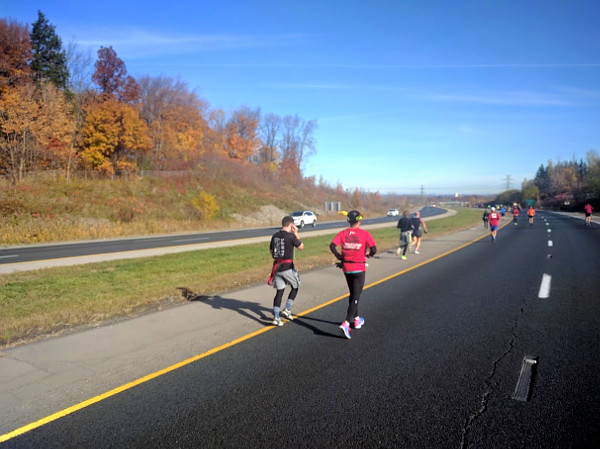
Keeping pace with the Pace Bunny
The course exited the RHVP at Barton Street, turned left, and then joined the Red Hill Valley Trail, which runs parallel to the highway to its west. This was a very short but welcome section of trail running on a route that was otherwise mostly on the road.
The Trail connects with the red pedestrian bridge that crosses the Queen Elizabeth Way (QEW) and then switches to Van Wagner's Beach Road and the Hamilton Beach Trail.
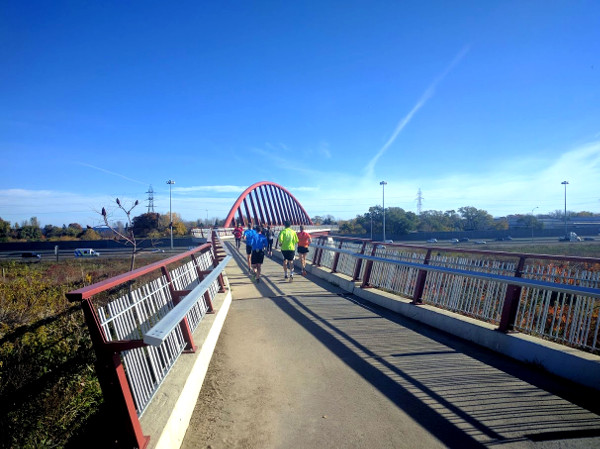
Pedestrian bridge over QEW
The route then turned left, or westbound, and ran along the Trail for almost two kilometres before jogging left onto Beach Boulevard.
5 The Agonizing Final Stretch ↑
My longest training run was a little over 32 km, so when I crossed the 33 km marker, I knew I was entering uncharted territory. It is a common claim that if you can run 32 km, you can run 42 km, and I was about to put this to the test.
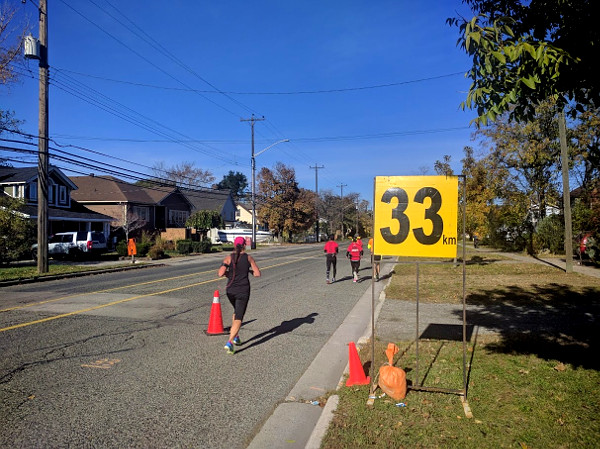
33 km and uncharted territory
This is where the hardest, most gruelling part of the entire marathon began for me. My left hip started to hurt and my right knee started feeling really tight. I tried to focus on my running form and just keep moving forward, but it became harder to keep up with the Pace Bunny.
It was another three km to the turnaround, but it felt a lot longer. At the 36 km point, the course looped to the right and rejoined the Beach Trail for the final six kilometres.
I must have accidentally dropped my bag of cashew-date bar pieces at some point during this stretch, because I went to reach for a piece and realized the bag was gone from my pocket.
I felt increasingly exhausted, both physically and mentally, and the Pace Bunny started receding into the distance. During km 39 and 40, my pace flagged. In the last couple of kilometres, I became emotionally despondent. I had a tremendous urge to just give up running and walk the last of it.
During this time, the supporters lining the course became my life preservers. Every person who looked me in the eyes and called a word of encouragement - "You can do it!" "Stay strong!" "You're just about there!" - helped propel me forward.
One woman was holding a sign that read, "THIS PARADE SUCKS". I burst out laughing, and it was like a mental fog lifted. I rallied for the last kilometre and pulled my pace back up - but it wasn't quite enough to catch up to the Pace Bunny again.
Finally, I could hear the energetic noise of the finish line just around the last bend, and I decided to cross the finish line as vigorously as possible. In that moment, I wanted the race to be over more than I wanted to stop running.
6 The Finish Line ↑
There was a sensor about 50 metres back from the finish line so the emcee could announce the names of people as they were crossing. I could hear him saying things like, "So and so from Hamilton, looking strong!" and I was eager to hear the announcement that I was done.
When you finish a race, the organizers report a gun time and a chip time. The gun time is the duration from when the race begins until you cross the finish line, whereas the chip time is the duration from when you cross the starting line until you cross the finish line. (With 900 runners all starting at the same time, only the people at the very front of the line cross the starting line right as the gun goes off.)
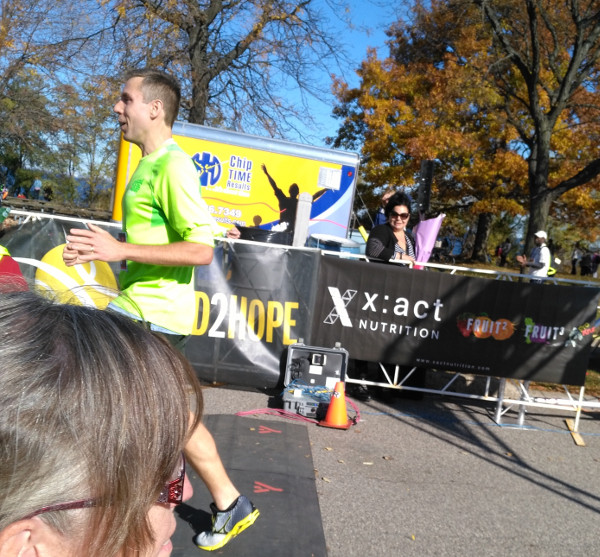
Me crossing the finish line (Image Credit: Sheri Selway)
I crossed the finish line with a gun time of 4:01:18 and a chip time of 4:00:50. My gun-time pace was 5:43 min/km (10.5 km/h), ever so slightly shy of the pace I needed to finish the marathon in under 4 hours.
That finishing time put me right in the middle of the pack - 445th place out of 900. By gender, I was in 308th place among 564 male entries. Among 97 total men age 40-44, I was in 66th place.
For a starker comparison, the first-place finisher, Adam Hortian of Kitchener, completed the marathon in 2:29:55 at a blistering pace of 3:34 minutes/km (16.82 km/h).
The bottom line is that I wanted to run it somewhere between 4 hours and 4 hours, 10 minutes or so - an ambitious (for my level of fitness) but achievable goal, and I managed to do it.
Yes, I'm a bit chagrined that I fell just 50 seconds short of finishing in 4 hours exactly. I found myself wondering if I would have made it, for example, if I didn't stop to take photographs, or if I had brought my own water instead of stopping at water stations.
But when it comes down to it, I have to acknowledge that this kind of rumination is moving the goalposts instead of accepting that I did, in fact, achieve my goal.
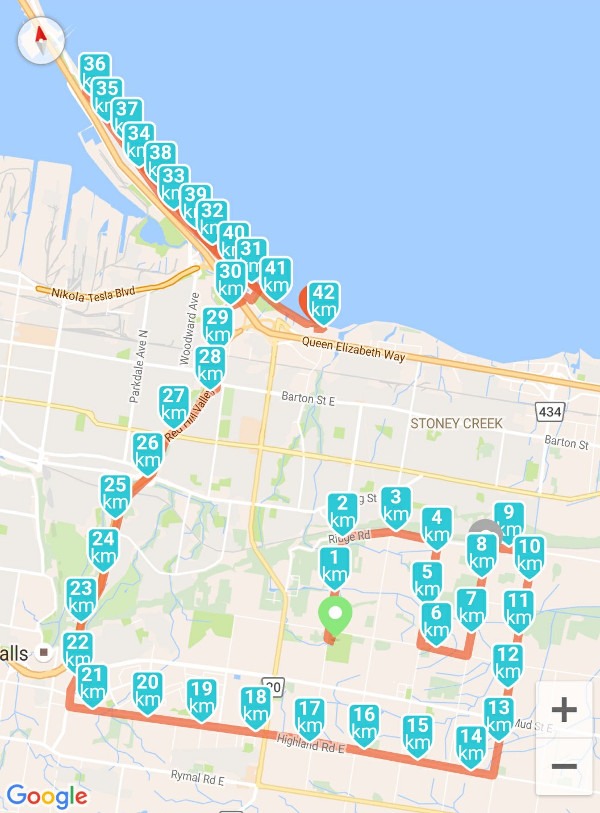
My run-tracking app's record of the route (Image Credit: Runkeeper)
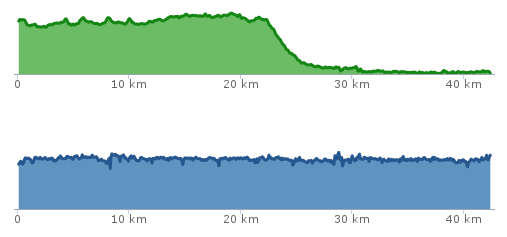
Charts: elevation change (top) and speed (Image Credit: Runkeeper)
7 Time to Stop Running Now ↑
Just past the finish line, an array of volunteers gently helped each runner manage the transition from running to not running. The first volunteer gave me a medal of completion (reminding me ruefully of the "participation" medals I used to receive for my underwhelming athletic accomplishments as a child), and the next gave me a bottle of water.
A medical first responder checked in with me to ask if I was feeling okay, and then it was into the tent for a banana, an apple, a slice of doughy grocery store tomato sauce pizza, and a bowl of hot, salty vegetable soup. They were quite possibly the most delicious things I have ever eaten - exactly what I needed.
Outside the tent, a great cover band called Jukebox Jury were killing it with an awesome cover of "Tom Sawyer" by Rush. (Alas, a missed opportunity to play the more appropriate "Marathon".)
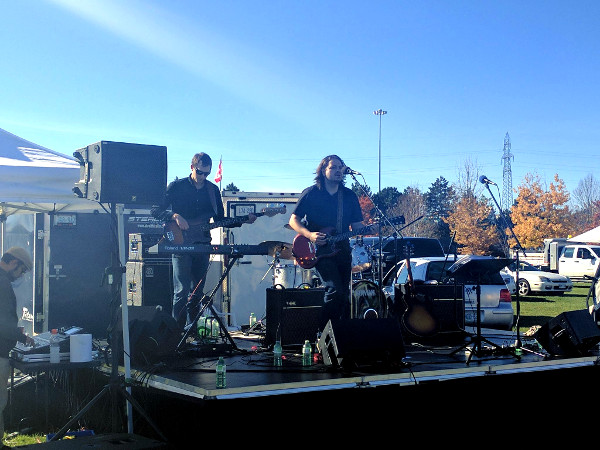
Jukebox Jury playing 'Tom Sawyer' by Rush outside the finish line
After catching up with some friends, I retrieved my windbreaker from the coat check, clambered into the car and headed home. I had to stop about halfway, pull over into a parking lot and walk around a bit to stop my legs from seizing up.
When I got home, I had a bath and then went to the grocery store to pick up our weekly groceries. This was probably the best thing I could have done: meandering slowly up and down the aisles was exactly the kind of mild, low-intensity recovery movement my body needed to avoid stiffening too badly.
By the end of the day, I had logged just over 50,000 steps on my pedometer. Around 41,000 of those were during the marathon, which means I have an average running stride length of 1.03 metres per step, or 2.06 metres per stride.
If we divide my 41,000 steps by the 241 minutes I spent running, we get an average cadence of 170 steps per minute. That's actually a bit slow: serious distance runners tend to maintain a cadence of 180+ steps per minute. (Time to focus on increasing my average cadence!)
8 The Next Day ↑
Training for and then running a marathon is a major physical undertaking that puts a huge amount of stress on the body. Every system is traumatized: your muscles, ligaments, tendons, fascia, bones, and cardiovascular system are subjected to extraordinary strain.
Damage occurs from the macro structure level right down to the cellular. Bloodstream markers for this damage and inflammation - creatine kinase, lactate dehydrogenase, uric acid, aminotransferases, creatinine, interleukin-6, C-reactive protein and so on - can persist for several days after the race.
I woke up the morning after the marathon and evaluated how my body was doing. Other than the kind of general exhaustion, stiffness and achiness that is to be expected, I wasn't doing too badly.
My thighs were probably the sorest part of my body, particularly on the front and upper outside. The bottoms of my feet were a bit tender and my ankles felt tired. Surprisingly, my calves felt pretty good, and my hips felt okay too.
I also felt rather, well, run-down. All the stress and damage from running a marathon compromises your immune system, and it's common for people to come down with colds in the days after finishing one. I hope I'll be okay, but I can certainly understand how someone is more likely to get sick.
All in all, despite feeling a bit like my body had been put through an industrial laundry press, I think I've gotten off fairly easy. The great news is that I don't seem to have sustained any injuries.
At lunchtime on Monday, I went for an easy 5.5 km walk along the Escarpment Trail, which is really beautiful this time of year. My thighs ached - especially going down stairs! - but the walk definitely helped to loosen things up.
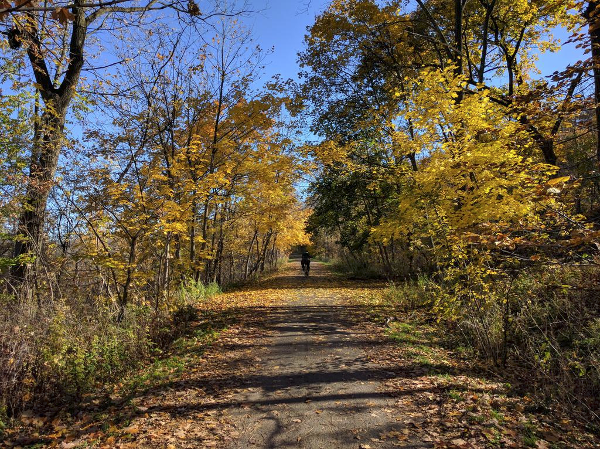
Recovery walk on Escarpment Trail
I'm going to try and keep moving this week with low-intensity exercise - lots of walking, some casual bicycling, plus daily stretches and core exercises. Toward the end of the week, I'll take stock of how I'm feeling and see if my body feels like going for a short, easy recovery run.
9 Why a Marathon ↑
The obvious reason for taking this on is that my running has followed a gradual upward trajectory in terms of weekly distance and speed over the past three and a half years, and a marathon was the next major milestone - indeed, it is the major milestone of endurance running.
Of course, there is a whole astonishing world of ultra-running beyond 42.195 km, but the marathon has a deep cultural and historical significance.
The marathon also occupies a sweet spot in terms of human achievement: it is a difficult physical and mental feat that requires months of training, dedication and endurance, but it remains accessible to almost anyone who decides they really want to do it.
Crossing the finish line is the last step of a process that takes months, not hours. The accomplishment is not so much physically completing the race as it is succeeding in having prepared your body to be able to do it.
Running is not actually that difficult. Running is nothing more than rhythmically hopping forward from one foot to the other while swinging your arms in a counterbalancing rhythm. Toddlers generally learn to run before they are two years old.
Running does not require a lot of coordination or agility or athletic prowess. We humans are natural runners, descended from ancestors who survived to pass their DNA down to us precisely because they were able to run. It is our shared birthright to run far and well.
Of course, elite runners are extraordinary, but even us mediocre runners are pretty remarkable. The average human is capable of amazing achievements. It is entirely a matter of commitment and dedication.
If you put in the time and effort, listen to your body, manage the risk of injury and keep patient, you will become a runner.
10 Postscript: The Aftermath ↑
So the crash came after all. I went to bed on Monday and couldn't sleep. I tossed and turned all night and woke up feeling like garbage. Tuesday came with a headache, fever, chills, dizziness, nausea and extreme fatigue.
I staggered into bed at 6:00 PM and slept until 7:30 AM on Wednesday. I had a two-hour nap on Wednesday afternoon and went to bed at 7:00 PM. I woke up at my usual time on Thursday, feeling almost normal again. Hey, at least my thighs weren't hurting any more.
I found myself reflecting that I had to put so many hours into training for this marathon that running had begun to feel a bit like a chore and a burden rather than an unalloyed pleasure.
I love running - up to around 25 km at a time and 55 km in a given week. As my weekly training pushed me farther and farther beyond that, it increasingly started to feel like a grind. Compared to a marathon, the Around the Bay race is a nice distance at 30 km - a bit farther than my normal long run but not a tremendous stretch.
Even as I allowed myself to feel proud of having run a marathon once, it occurred to me that I would need a pretty strong reason to sign up for another one.
After a five-day break from running - almost an eternity! - I went out for my first post-marathon run on Saturday, November 12, a nice short 5.7 km jaunt on a local trail. The following week, I did three 9-10 km weekday runs, marvelling each time that I could still feel lingering fatigue and stiffness.
I did a gentle, low-intensity 21 km long run on the morning of Sunday, November 20 - exactly two weeks after the marathon - and it felt wonderful to go for a long run without any agenda. I wasn't aiming for a particular distance or a particular pace, and running felt straight-up fun again for the first time in a while.
Amazingly, it wasn't until my third week after the marathon that I actually felt 100 percent recovered. And God help me, I've already started thinking maybe I'd like to do another marathon after all...